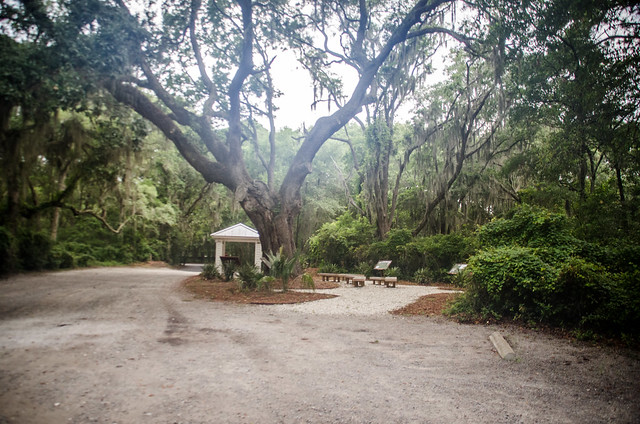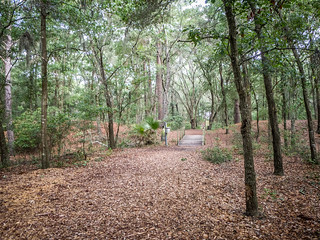
NOTE: Yeah, I’m still behind on blogging. Now I’m about two weeks behind, but I’m slowly catching up. 🙂
A few months ago I learned about an exhibit at USC’s McKissick Museum about the town of Mitchelville. As I read more about Mitchelville, I knew I had to add this one to my list of South Carolina ghost towns. The recent trip to Bluffton offered the perfect opportunity to explore this town on the northeast shore of Hilton Head.
During the Civil War Union troops captured Hilton Head Island and established that as one of their bases of operations. Beginning in 1861 escaped slaves, or “contrabands” as they were called, sought refuge on the island. The Union soldiers were unsure of what to do with the slaves, so in late 1862 General Ormsby M. Mitchel allowed the escaped African Americans to establish the town of Mitchelville. This one of the first examples of the Port Royal Experiment, where African Americans were given control of the land to work for wages.


Union Army resources were used to provide lumber for the construction of churches, a school, and housing for the now “Freedmen”. According to the Wikipedia article…
Military sawmills provided free lumber for, and the ex-slaves provided the labor for the houses. Each house had a quarter-acre lot. The typical house measured approximately 12x12ft, were of frame construction, had wood pier foundations, glass-paned windows, wood floors, weatherboard siding, wood shingle roofs, and having either metal stoves or brick and/or tabby or wattle and daub (“stick”) chimneys. There were four stores in Mitchelville, with several of them closing down, perhaps for overcharging the residents (supplies sold in Mitchelville were priced nearly 600% higher than those sold by the AMA) (Trinkley/CRC-21 1987).
As part of the Port Royal Experiment, the Hilton Head lands formerly owned by Thomas Drayton had been confiscated and given to the Freedmen. In 1875 those lands were returned to the Draytons, but they had lost interest in farming that area. The land was sold at greatly reduced prices, much of it to residents of Mitchelville. The town ceased to be a true town by the 1880s, but the community of Mitchelville continued as a mostly kinship-based community.
The Mitchelville area remained largely undeveloped until the present day. This portion of the island remained a predominantly African American neighborhood, with much more modest homes than the resort developments popping up on other parts of the island. As land became scarce, though, this couldn’t last. For example, one developer has this on their website…
Mitchelville, South Carolina, represents the last 300 acres of primarily undeveloped beach property available on famed Hilton Head. Featuring Hilton Head’s most scenic natural landscape, the Mitchelville area, established in 1862 as the first township for freed men in the United States, is now being redeveloped into a beach township specifically designed to cater to those seeking an active, upscale beach lifestyle in a relaxed, non-resort environment. The new Mitchelville will offer residents and vacationers an unparalleled Island community where they can relax and entertain family and friends while investing in history. The exquisitely designed and custom built single family homes that make up the new Mitchelville will offer the ultimate weekend beach getaway experience, and will surely be passed down from generation to generation.
Realizing the threats to the area, the Mitchelville Preservation Project was founded in 2005 to “preserve, protect and promote the heritage of Mitchelville, America’s first post-Civil War settlement for freed slaves.” One of the organization’s goals is the development of the Mitchelville Freedom Park, to preserve and commemorate the area.
Having spent the night in Okatie, my plan was to get up early and drive down to Fish Haul Creek Park, the future home of the Mitchelville Freedom Park. I was hoping to catch the sunrise over the shore. However, when I awoke it was to the sound of rain, so good sunrise photography was out of the question.
I drove on over to Hilton Head, albeit with a ton of traffic. This being the first Saturday of the Fourth Holiday Week, everyone wanted to get onto the island. I was able to find the correct road, and drove past the Hilton Head Airport on my way to the site.
There is a Mitchelville Beach Park on Mitchelville Road, but the actual town location and the historic park are at Fish Haul Creek Park.
I was the only one there at that early hour. The rain had stopped, but it was incredibly muggy. As soon as I got out of my air-conditioned car with my camera, the lens fogged up. For awhile I had to rely on my little Panasonic and iPhone for photos.
At the entrance to the park is a covered display area with interpretive signs providing the history of the area. A series of benches is set up as a lecture area.
A trail leads through the live oak hardwood forest, with more signs.
The trail leads to an overlook of Fish Haul Creek. A bench donated by the Toni Morrison Society to honor the novelist and commemorate the town looks out over the marsh area.
Just beyond the bench a boardwalk/pier leads out to an observation area with a nice gazebo. The clouds were starting to break up, so I was able to capture the early morning sun after all.
The trail continues on through the coastal oak forest. A side trail led off deeper into the woods, but I stayed on the larger path that wound next to the marsh and creek.
I soon came to a covered picnic shelter, and beyond that was a beach access overlooking the Port Royal Sound.
The humidity was really starting to get to me, and my cameras were suffering. I made my way back to the parking area and decided to explore the area a bit more. I drove on over to Mitchelville Beach Park. This park is developed more for community recreation, with ball parks, playgrounds, and beach access. As a park, the facilities are quite nice. However, the historic value of the area is not in evidence. I parked and walked across a long boardwalk connecting the parking area to the playground, then wandered out onto the beach for a moment. It was low tide, and muddy sand stretched for many yards.
Back at the car I continued along the dirt Mitchelville Road, looking at the neighborhood. By Hilton Head standards, the homes were very modest, consisting of small wood frame homes and mobile homes. However, there were tell-tale signs of the pending development and plans for the area.
Back out on the main road I stopped by St. James Baptist Church, one of the only organizations to have survived from the Mitchelville Days. The current building was constructed in 1972.
I had one more stop, though. Across from the airport in the woods is the location of Fort Howell, the base of operations for the Union soldiers on the island. All that remains are the raised earthworks outlining the fort. There were interpretive signs, but some of these appeared to be in bad repair and almost unreadable. I spent a little bit of time, but I had along drive ahead of me, so I didn’t stay long.
Mitchelville does have a fascinating history. I hope the Mitchelville Preservation Society and keep the developers at bay, and realize their goals of preserving this important African American heritage site.
View Mitchelville in a larger map
[fsg_gallery id=”4″]





























